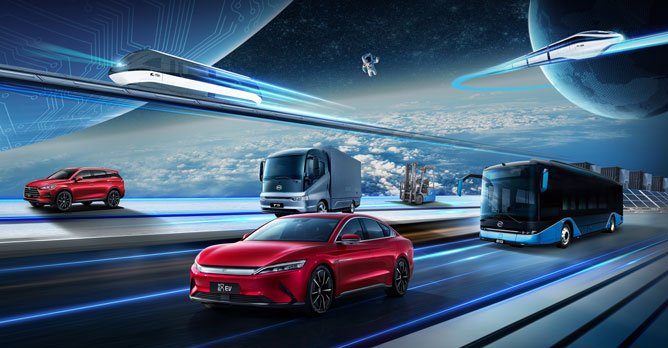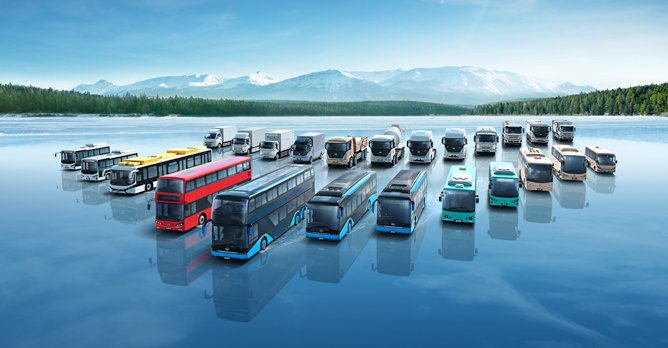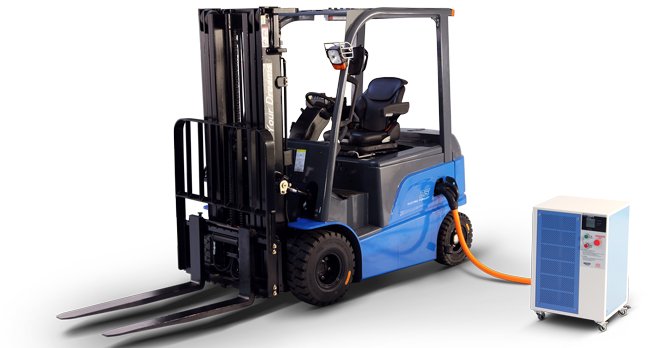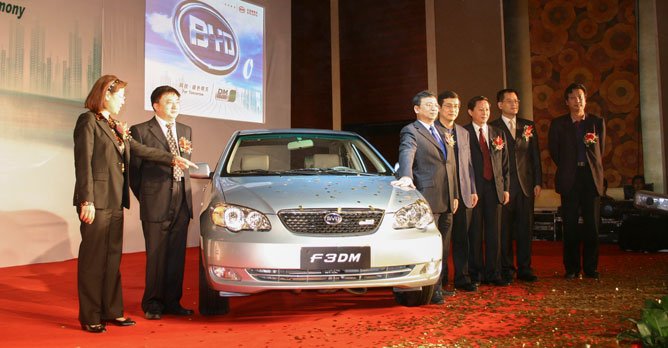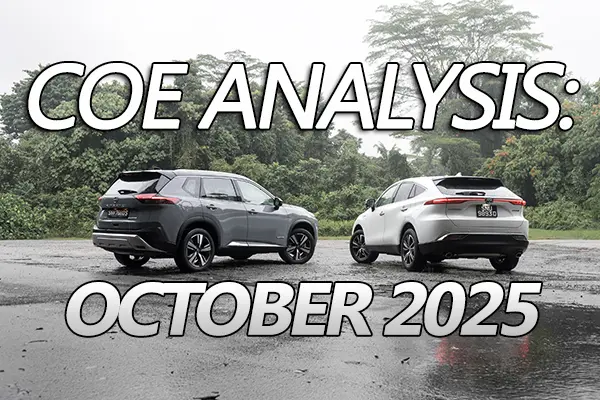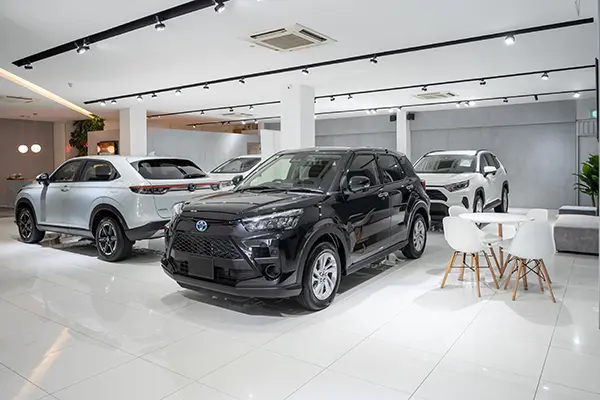BYD makes electric cars, commercial vehicles, and so much more
17 Nov 2022|4,353 views
To most consumers in Singapore, Chinese brand BYD is simply a manufacturer of electric cars, with models such as the T3 commercial van, M3e and e6 MPVs and its latest passenger car, the Atto 3 crossover.
What they would be surprised to know, however, is that BYD's businesses actually encompass an even wider range of industries.
In its quest to grow its battery business, BYD has evolved into manufacturing automobiles, forklifts and larger commercial vehicles while also producing electronics and making inroads in rail transit as well.
Diversified companies like these are certainly not uncommon. However, it is how and why BYD transformed itself from a small manufacturer into a global powerhouse that it is today in 27 relatively short years of operation that makes it such a compelling story - and why we all need to sit up and pay attention.
Energising dreams
Appropriately enough, BYD (which stands for 'Build Your Dreams') began life as a battery manufacturer, making rechargeable NiCD (nickel-cadmium) batteries for mobile phones in Shenzhen, China.
It was founded in 1994 by Chinese entrepreneur Wang Chuan Fu, who has a chemistry background and is also the company's CEO.
Business was good. However, it wasn't long before Wang began thinking about how to expand his battery business. In the early 2000s, few companies were thinking about electric cars.
But Wang realised that apart from being good for his main business, electric cars could also be a future mobility solution. China gets more than half of its oil from foreign sources, and this supply could be easily affected by external shocks.
However, if more people drove electric cars instead of internal combustion ones, then China's reliance on foreign oil would be lower.
A shift to 'new energy' vehicles, such as electric cars, hybrids and plug-in hybrids, would also decrease tailpipe emissions and thereby help reduce pollution, which remains a problem in the country.
But a battery-maker going into car-manufacturing, without any prior experience, was unheard of at this point. And going through the route of applying for a car manufacturing licence and setting up a factory would take too long and be too capital-intensive.
An opportunity presented itself in 2003 when Norinco, a conglomerate that is primarily involved in the defence industry, wanted to offload Qinchuan Automobile, an ailing carmaker.
Through its acquisition of Qinchuan, BYD got its foothold in car manufacturing.
Automotive inroads
BYD moved quickly following its entry into carmaking. Qinchuan was renamed BYD Auto and in 2005, the brand launched the F3, a sedan based on the Toyota Corolla Altis.
BYD's goal, however, was to manufacture electric cars. So, in 2008, it took a step closer to this when it launched the F3DM, which has a plug-in hybrid drivetrain.
Said drivetrain consists of a 1.0-litre three-cylinder petrol engine and two AC electric motors. One motor drives the wheels, while the other can supplement the first motor by providing power or help charge the battery pack through regenerative braking.
Unique to the F3DM is its use of a lithium iron phosphate - or lithium-ferro phosphate (LFP) batteries - instead of lithium-ion or nickel-metal hydride batteries. While LFP batteries have less energy content compared to lithium-ion batteries, not only are they more stable, making them safer in the event of an accident, but they also cost less to produce as they don't contain nickel or cobalt.
Nickel and cobalt are also subject to supply and mining constraints, so these sourcing issues are avoided.
In 2009, BYD launched its first EV, an MPV called the e6, which was soon followed by both petrol-powered and plug-in hybrid models. These included the Qin compact saloon in 2012, Song crossover in 2015 and Song Max MPV in 2017.
However, by March 2022, BYD halted the production of internal combustion models in March 2022 to focus on electric and plug-in hybrid vehicles instead - and for good reason.
By the second quarter of this year, BYD had surpassed Tesla to become the world's top EV brand. According to Counterpoint, a global industry analysis firm, BYD shipped over 354,000 EVs in the second quarter of 2022, a 266% increase year-on-year (figures are correct at time of writing).
Cutting-edge energy
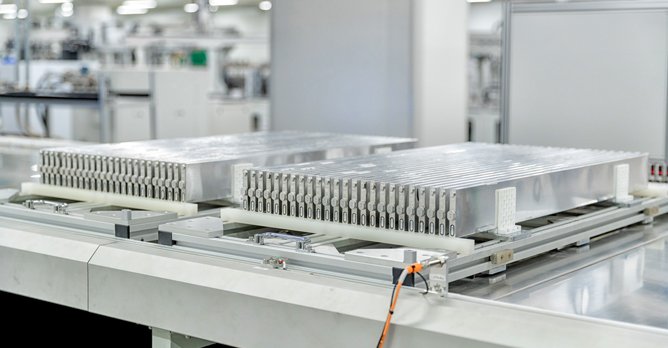
 By installing the cells on their sides, the Blade Battery's packaging is stronger and more efficient We can't talk about EVs without discussing the Blade Battery, the invention that solidified BYD's lead in battery technology and made other EV makers sit up and take notice.
By installing the cells on their sides, the Blade Battery's packaging is stronger and more efficient We can't talk about EVs without discussing the Blade Battery, the invention that solidified BYD's lead in battery technology and made other EV makers sit up and take notice.
Launched in March 2020, BYD claims the Blade Battery is even safer than its LFP battery. To prove this, BYD performed the Nail Penetration Test, wherein a nail is used to penetrate the Blade Battery to simulate a short-circuit.
During tests, the Blade Battery's surface temperature was shown to have risen between 30 degrees to 60 degrees Celsius. The increase in heat was not even enough to cook a raw egg that had been placed on top of it.
In comparison, lithium-ion batteries subjected to the Nail Penetration Test end up in a ball of flame, with temperatures exceeding 500 degrees Celsius. Battery fires are extremely difficult to put out, so preventing this from happening, especially in the event of a mishap, is a must.
Coupled with its proven safety advantage - a top priority for both electric car manufacturers and buyers - with efficient packaging and its strong structure, the Blade Battery has made an impact beyond BYD's own cars.
Tesla, for one, is already using the Blade Battery in Model Ys that are produced in the Giga Berlin Factory. Even car manufacturing giant Toyota has signed an agreement with BYD to use the Blade Battery for upcoming electric models.
The Blade Battery will be utilised by BYD's flagship Han saloon. Since April 2021, it has been fitted to the brand's new electric-only models.
Electronics whizz
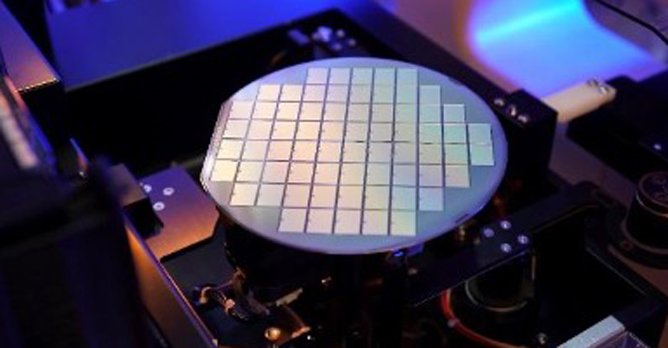
 BYD's move into semiconductors helped make it the only Chinese carmaker with a complete industrial chain for IGBTs for EVs The Blade Battery is not the only BYD product that has seen success beyond its own backyard.
BYD's move into semiconductors helped make it the only Chinese carmaker with a complete industrial chain for IGBTs for EVs The Blade Battery is not the only BYD product that has seen success beyond its own backyard.
BYD's electric powertrains depend on an Insulated Gate Bipolar Transistor (IGBT), which controls the conversion between direct current and alternating current. It also determines the electric motor's output.
Given the IGBT's importance, BYD established a semiconductor division (BYD Semiconductor) in 2004. BYD is the only Chinese carmaker with a complete industry chain of IGBTs for automobiles.
That means the design, production and application of IGBTs to EV models are all done in-house. Its latest product, IGBT 4.0, can supposedly output 15% more current compared to competing products, thereby helping improve the performance of its EVs.
BYD also continues to manufacture electronic components for brands such as Samsung, Apple and Motorola, through BYD Electronic. Once a subsidiary of BYD, it has since been spun off and now operates as an independent entity. The company's other products include energy storage systems and photovoltaic components as well.
And rail, too
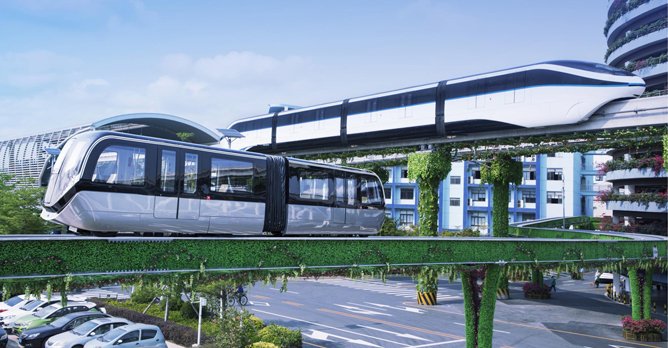
 SkyRail supposedly costs a fifth of what a subway system would cost, and the carriage interiors are made with non-combustible materials for safety It doesn't stop there. Apart from electric cars and commercial vehicles such as buses and trucks, BYD also manufactures the SkyRail, a monorail that runs on an elevated single-track beam.
SkyRail supposedly costs a fifth of what a subway system would cost, and the carriage interiors are made with non-combustible materials for safety It doesn't stop there. Apart from electric cars and commercial vehicles such as buses and trucks, BYD also manufactures the SkyRail, a monorail that runs on an elevated single-track beam.
BYD manufactures the entire system, from tracks to carriages to communication components. According to BYD, SkyRail costs '20% of what a subway system' would cost.
For safety, the SkyRail carriage interiors are built with non-combustible materials. And in case of a power outage, SkyRail is claimed to be able to travel for another three kilometres on its back-up batteries.
Future outlook
In less than 30 years, BYD has grown and evolved from being a domestic maker of rechargeable batteries into a global conglomerate that makes automobiles, batteries, semiconductors, electronic components, energy storage systems and rail transit components.
Its Blade Battery and powertrains will probably be utilised by more carmakers as the EV industry continues to grow. We can also expect to see more of its models in Singapore in the future.
Now, even if you don't drive the brand's cars, you're probably using a product whose components were produced by BYD. Whether it's the smartphone that keeps you connected, your laptop that lets you crunch numbers on the go, or the tablet you use for entertainment, it's likely that the brand had a hand in their production.
For entrepreneurs out there, here's an interesting thought: BYD, which stands for Build Your Dreams, is in some way, shape of form, helping you build yours, too. And that's why this brand deserves a good long look.
Looking for more EV content? These stories may interest you
LTA: At least 12,000 charging points installed across all HDB carparks by 2025
6 things you need to know before getting your first electric car
Toyota announces 600km plus bZ3, which is jointly developed by BYD and FAW Toyota
BMW iX3 gets exterior refresh and more modern cabin equipment
What they would be surprised to know, however, is that BYD's businesses actually encompass an even wider range of industries.
In its quest to grow its battery business, BYD has evolved into manufacturing automobiles, forklifts and larger commercial vehicles while also producing electronics and making inroads in rail transit as well.
Diversified companies like these are certainly not uncommon. However, it is how and why BYD transformed itself from a small manufacturer into a global powerhouse that it is today in 27 relatively short years of operation that makes it such a compelling story - and why we all need to sit up and pay attention.
Energising dreams
Appropriately enough, BYD (which stands for 'Build Your Dreams') began life as a battery manufacturer, making rechargeable NiCD (nickel-cadmium) batteries for mobile phones in Shenzhen, China.
It was founded in 1994 by Chinese entrepreneur Wang Chuan Fu, who has a chemistry background and is also the company's CEO.
Business was good. However, it wasn't long before Wang began thinking about how to expand his battery business. In the early 2000s, few companies were thinking about electric cars.
But Wang realised that apart from being good for his main business, electric cars could also be a future mobility solution. China gets more than half of its oil from foreign sources, and this supply could be easily affected by external shocks.
However, if more people drove electric cars instead of internal combustion ones, then China's reliance on foreign oil would be lower.
A shift to 'new energy' vehicles, such as electric cars, hybrids and plug-in hybrids, would also decrease tailpipe emissions and thereby help reduce pollution, which remains a problem in the country.
But a battery-maker going into car-manufacturing, without any prior experience, was unheard of at this point. And going through the route of applying for a car manufacturing licence and setting up a factory would take too long and be too capital-intensive.
An opportunity presented itself in 2003 when Norinco, a conglomerate that is primarily involved in the defence industry, wanted to offload Qinchuan Automobile, an ailing carmaker.
Through its acquisition of Qinchuan, BYD got its foothold in car manufacturing.
Automotive inroads
BYD moved quickly following its entry into carmaking. Qinchuan was renamed BYD Auto and in 2005, the brand launched the F3, a sedan based on the Toyota Corolla Altis.
BYD's goal, however, was to manufacture electric cars. So, in 2008, it took a step closer to this when it launched the F3DM, which has a plug-in hybrid drivetrain.
Said drivetrain consists of a 1.0-litre three-cylinder petrol engine and two AC electric motors. One motor drives the wheels, while the other can supplement the first motor by providing power or help charge the battery pack through regenerative braking.
Unique to the F3DM is its use of a lithium iron phosphate - or lithium-ferro phosphate (LFP) batteries - instead of lithium-ion or nickel-metal hydride batteries. While LFP batteries have less energy content compared to lithium-ion batteries, not only are they more stable, making them safer in the event of an accident, but they also cost less to produce as they don't contain nickel or cobalt.
Nickel and cobalt are also subject to supply and mining constraints, so these sourcing issues are avoided.
In 2009, BYD launched its first EV, an MPV called the e6, which was soon followed by both petrol-powered and plug-in hybrid models. These included the Qin compact saloon in 2012, Song crossover in 2015 and Song Max MPV in 2017.
However, by March 2022, BYD halted the production of internal combustion models in March 2022 to focus on electric and plug-in hybrid vehicles instead - and for good reason.
By the second quarter of this year, BYD had surpassed Tesla to become the world's top EV brand. According to Counterpoint, a global industry analysis firm, BYD shipped over 354,000 EVs in the second quarter of 2022, a 266% increase year-on-year (figures are correct at time of writing).
Cutting-edge energy

Launched in March 2020, BYD claims the Blade Battery is even safer than its LFP battery. To prove this, BYD performed the Nail Penetration Test, wherein a nail is used to penetrate the Blade Battery to simulate a short-circuit.
During tests, the Blade Battery's surface temperature was shown to have risen between 30 degrees to 60 degrees Celsius. The increase in heat was not even enough to cook a raw egg that had been placed on top of it.
In comparison, lithium-ion batteries subjected to the Nail Penetration Test end up in a ball of flame, with temperatures exceeding 500 degrees Celsius. Battery fires are extremely difficult to put out, so preventing this from happening, especially in the event of a mishap, is a must.
Coupled with its proven safety advantage - a top priority for both electric car manufacturers and buyers - with efficient packaging and its strong structure, the Blade Battery has made an impact beyond BYD's own cars.
Tesla, for one, is already using the Blade Battery in Model Ys that are produced in the Giga Berlin Factory. Even car manufacturing giant Toyota has signed an agreement with BYD to use the Blade Battery for upcoming electric models.
The Blade Battery will be utilised by BYD's flagship Han saloon. Since April 2021, it has been fitted to the brand's new electric-only models.
Electronics whizz

BYD's electric powertrains depend on an Insulated Gate Bipolar Transistor (IGBT), which controls the conversion between direct current and alternating current. It also determines the electric motor's output.
Given the IGBT's importance, BYD established a semiconductor division (BYD Semiconductor) in 2004. BYD is the only Chinese carmaker with a complete industry chain of IGBTs for automobiles.
That means the design, production and application of IGBTs to EV models are all done in-house. Its latest product, IGBT 4.0, can supposedly output 15% more current compared to competing products, thereby helping improve the performance of its EVs.
BYD also continues to manufacture electronic components for brands such as Samsung, Apple and Motorola, through BYD Electronic. Once a subsidiary of BYD, it has since been spun off and now operates as an independent entity. The company's other products include energy storage systems and photovoltaic components as well.
And rail, too

BYD manufactures the entire system, from tracks to carriages to communication components. According to BYD, SkyRail costs '20% of what a subway system' would cost.
For safety, the SkyRail carriage interiors are built with non-combustible materials. And in case of a power outage, SkyRail is claimed to be able to travel for another three kilometres on its back-up batteries.
Future outlook
In less than 30 years, BYD has grown and evolved from being a domestic maker of rechargeable batteries into a global conglomerate that makes automobiles, batteries, semiconductors, electronic components, energy storage systems and rail transit components.
Its Blade Battery and powertrains will probably be utilised by more carmakers as the EV industry continues to grow. We can also expect to see more of its models in Singapore in the future.
Now, even if you don't drive the brand's cars, you're probably using a product whose components were produced by BYD. Whether it's the smartphone that keeps you connected, your laptop that lets you crunch numbers on the go, or the tablet you use for entertainment, it's likely that the brand had a hand in their production.
For entrepreneurs out there, here's an interesting thought: BYD, which stands for Build Your Dreams, is in some way, shape of form, helping you build yours, too. And that's why this brand deserves a good long look.
Looking for more EV content? These stories may interest you
LTA: At least 12,000 charging points installed across all HDB carparks by 2025
6 things you need to know before getting your first electric car
Toyota announces 600km plus bZ3, which is jointly developed by BYD and FAW Toyota
BMW iX3 gets exterior refresh and more modern cabin equipment
To most consumers in Singapore, Chinese brand BYD is simply a manufacturer of electric cars, with models such as the T3 commercial van, M3e and e6 MPVs and its latest passenger car, the Atto 3 crossover.
What they would be surprised to know, however, is that BYD's businesses actually encompass an even wider range of industries.
In its quest to grow its battery business, BYD has evolved into manufacturing automobiles, forklifts and larger commercial vehicles while also producing electronics and making inroads in rail transit as well.
Diversified companies like these are certainly not uncommon. However, it is how and why BYD transformed itself from a small manufacturer into a global powerhouse that it is today in 27 relatively short years of operation that makes it such a compelling story - and why we all need to sit up and pay attention.
Energising dreams
Appropriately enough, BYD (which stands for 'Build Your Dreams') began life as a battery manufacturer, making rechargeable NiCD (nickel-cadmium) batteries for mobile phones in Shenzhen, China.
It was founded in 1994 by Chinese entrepreneur Wang Chuan Fu, who has a chemistry background and is also the company's CEO.
Business was good. However, it wasn't long before Wang began thinking about how to expand his battery business. In the early 2000s, few companies were thinking about electric cars.
But Wang realised that apart from being good for his main business, electric cars could also be a future mobility solution. China gets more than half of its oil from foreign sources, and this supply could be easily affected by external shocks.
However, if more people drove electric cars instead of internal combustion ones, then China's reliance on foreign oil would be lower.
A shift to 'new energy' vehicles, such as electric cars, hybrids and plug-in hybrids, would also decrease tailpipe emissions and thereby help reduce pollution, which remains a problem in the country.
But a battery-maker going into car-manufacturing, without any prior experience, was unheard of at this point. And going through the route of applying for a car manufacturing licence and setting up a factory would take too long and be too capital-intensive.
An opportunity presented itself in 2003 when Norinco, a conglomerate that is primarily involved in the defence industry, wanted to offload Qinchuan Automobile, an ailing carmaker.
Through its acquisition of Qinchuan, BYD got its foothold in car manufacturing.
Automotive inroads
BYD moved quickly following its entry into carmaking. Qinchuan was renamed BYD Auto and in 2005, the brand launched the F3, a sedan based on the Toyota Corolla Altis.
BYD's goal, however, was to manufacture electric cars. So, in 2008, it took a step closer to this when it launched the F3DM, which has a plug-in hybrid drivetrain.
Said drivetrain consists of a 1.0-litre three-cylinder petrol engine and two AC electric motors. One motor drives the wheels, while the other can supplement the first motor by providing power or help charge the battery pack through regenerative braking.
Unique to the F3DM is its use of a lithium iron phosphate - or lithium-ferro phosphate (LFP) batteries - instead of lithium-ion or nickel-metal hydride batteries. While LFP batteries have less energy content compared to lithium-ion batteries, not only are they more stable, making them safer in the event of an accident, but they also cost less to produce as they don't contain nickel or cobalt.
Nickel and cobalt are also subject to supply and mining constraints, so these sourcing issues are avoided.
In 2009, BYD launched its first EV, an MPV called the e6, which was soon followed by both petrol-powered and plug-in hybrid models. These included the Qin compact saloon in 2012, Song crossover in 2015 and Song Max MPV in 2017.
However, by March 2022, BYD halted the production of internal combustion models in March 2022 to focus on electric and plug-in hybrid vehicles instead - and for good reason.
By the second quarter of this year, BYD had surpassed Tesla to become the world's top EV brand. According to Counterpoint, a global industry analysis firm, BYD shipped over 354,000 EVs in the second quarter of 2022, a 266% increase year-on-year (figures are correct at time of writing).
Cutting-edge energy

 By installing the cells on their sides, the Blade Battery's packaging is stronger and more efficient We can't talk about EVs without discussing the Blade Battery, the invention that solidified BYD's lead in battery technology and made other EV makers sit up and take notice.
By installing the cells on their sides, the Blade Battery's packaging is stronger and more efficient We can't talk about EVs without discussing the Blade Battery, the invention that solidified BYD's lead in battery technology and made other EV makers sit up and take notice.
Launched in March 2020, BYD claims the Blade Battery is even safer than its LFP battery. To prove this, BYD performed the Nail Penetration Test, wherein a nail is used to penetrate the Blade Battery to simulate a short-circuit.
During tests, the Blade Battery's surface temperature was shown to have risen between 30 degrees to 60 degrees Celsius. The increase in heat was not even enough to cook a raw egg that had been placed on top of it.
In comparison, lithium-ion batteries subjected to the Nail Penetration Test end up in a ball of flame, with temperatures exceeding 500 degrees Celsius. Battery fires are extremely difficult to put out, so preventing this from happening, especially in the event of a mishap, is a must.
Coupled with its proven safety advantage - a top priority for both electric car manufacturers and buyers - with efficient packaging and its strong structure, the Blade Battery has made an impact beyond BYD's own cars.
Tesla, for one, is already using the Blade Battery in Model Ys that are produced in the Giga Berlin Factory. Even car manufacturing giant Toyota has signed an agreement with BYD to use the Blade Battery for upcoming electric models.
The Blade Battery will be utilised by BYD's flagship Han saloon. Since April 2021, it has been fitted to the brand's new electric-only models.
Electronics whizz

 BYD's move into semiconductors helped make it the only Chinese carmaker with a complete industrial chain for IGBTs for EVs The Blade Battery is not the only BYD product that has seen success beyond its own backyard.
BYD's move into semiconductors helped make it the only Chinese carmaker with a complete industrial chain for IGBTs for EVs The Blade Battery is not the only BYD product that has seen success beyond its own backyard.
BYD's electric powertrains depend on an Insulated Gate Bipolar Transistor (IGBT), which controls the conversion between direct current and alternating current. It also determines the electric motor's output.
Given the IGBT's importance, BYD established a semiconductor division (BYD Semiconductor) in 2004. BYD is the only Chinese carmaker with a complete industry chain of IGBTs for automobiles.
That means the design, production and application of IGBTs to EV models are all done in-house. Its latest product, IGBT 4.0, can supposedly output 15% more current compared to competing products, thereby helping improve the performance of its EVs.
BYD also continues to manufacture electronic components for brands such as Samsung, Apple and Motorola, through BYD Electronic. Once a subsidiary of BYD, it has since been spun off and now operates as an independent entity. The company's other products include energy storage systems and photovoltaic components as well.
And rail, too

 SkyRail supposedly costs a fifth of what a subway system would cost, and the carriage interiors are made with non-combustible materials for safety It doesn't stop there. Apart from electric cars and commercial vehicles such as buses and trucks, BYD also manufactures the SkyRail, a monorail that runs on an elevated single-track beam.
SkyRail supposedly costs a fifth of what a subway system would cost, and the carriage interiors are made with non-combustible materials for safety It doesn't stop there. Apart from electric cars and commercial vehicles such as buses and trucks, BYD also manufactures the SkyRail, a monorail that runs on an elevated single-track beam.
BYD manufactures the entire system, from tracks to carriages to communication components. According to BYD, SkyRail costs '20% of what a subway system' would cost.
For safety, the SkyRail carriage interiors are built with non-combustible materials. And in case of a power outage, SkyRail is claimed to be able to travel for another three kilometres on its back-up batteries.
Future outlook
In less than 30 years, BYD has grown and evolved from being a domestic maker of rechargeable batteries into a global conglomerate that makes automobiles, batteries, semiconductors, electronic components, energy storage systems and rail transit components.
Its Blade Battery and powertrains will probably be utilised by more carmakers as the EV industry continues to grow. We can also expect to see more of its models in Singapore in the future.
Now, even if you don't drive the brand's cars, you're probably using a product whose components were produced by BYD. Whether it's the smartphone that keeps you connected, your laptop that lets you crunch numbers on the go, or the tablet you use for entertainment, it's likely that the brand had a hand in their production.
For entrepreneurs out there, here's an interesting thought: BYD, which stands for Build Your Dreams, is in some way, shape of form, helping you build yours, too. And that's why this brand deserves a good long look.
Looking for more EV content? These stories may interest you
LTA: At least 12,000 charging points installed across all HDB carparks by 2025
6 things you need to know before getting your first electric car
Toyota announces 600km plus bZ3, which is jointly developed by BYD and FAW Toyota
BMW iX3 gets exterior refresh and more modern cabin equipment
What they would be surprised to know, however, is that BYD's businesses actually encompass an even wider range of industries.
In its quest to grow its battery business, BYD has evolved into manufacturing automobiles, forklifts and larger commercial vehicles while also producing electronics and making inroads in rail transit as well.
Diversified companies like these are certainly not uncommon. However, it is how and why BYD transformed itself from a small manufacturer into a global powerhouse that it is today in 27 relatively short years of operation that makes it such a compelling story - and why we all need to sit up and pay attention.
Energising dreams
Appropriately enough, BYD (which stands for 'Build Your Dreams') began life as a battery manufacturer, making rechargeable NiCD (nickel-cadmium) batteries for mobile phones in Shenzhen, China.
It was founded in 1994 by Chinese entrepreneur Wang Chuan Fu, who has a chemistry background and is also the company's CEO.
Business was good. However, it wasn't long before Wang began thinking about how to expand his battery business. In the early 2000s, few companies were thinking about electric cars.
But Wang realised that apart from being good for his main business, electric cars could also be a future mobility solution. China gets more than half of its oil from foreign sources, and this supply could be easily affected by external shocks.
However, if more people drove electric cars instead of internal combustion ones, then China's reliance on foreign oil would be lower.
A shift to 'new energy' vehicles, such as electric cars, hybrids and plug-in hybrids, would also decrease tailpipe emissions and thereby help reduce pollution, which remains a problem in the country.
But a battery-maker going into car-manufacturing, without any prior experience, was unheard of at this point. And going through the route of applying for a car manufacturing licence and setting up a factory would take too long and be too capital-intensive.
An opportunity presented itself in 2003 when Norinco, a conglomerate that is primarily involved in the defence industry, wanted to offload Qinchuan Automobile, an ailing carmaker.
Through its acquisition of Qinchuan, BYD got its foothold in car manufacturing.
Automotive inroads
BYD moved quickly following its entry into carmaking. Qinchuan was renamed BYD Auto and in 2005, the brand launched the F3, a sedan based on the Toyota Corolla Altis.
BYD's goal, however, was to manufacture electric cars. So, in 2008, it took a step closer to this when it launched the F3DM, which has a plug-in hybrid drivetrain.
Said drivetrain consists of a 1.0-litre three-cylinder petrol engine and two AC electric motors. One motor drives the wheels, while the other can supplement the first motor by providing power or help charge the battery pack through regenerative braking.
Unique to the F3DM is its use of a lithium iron phosphate - or lithium-ferro phosphate (LFP) batteries - instead of lithium-ion or nickel-metal hydride batteries. While LFP batteries have less energy content compared to lithium-ion batteries, not only are they more stable, making them safer in the event of an accident, but they also cost less to produce as they don't contain nickel or cobalt.
Nickel and cobalt are also subject to supply and mining constraints, so these sourcing issues are avoided.
In 2009, BYD launched its first EV, an MPV called the e6, which was soon followed by both petrol-powered and plug-in hybrid models. These included the Qin compact saloon in 2012, Song crossover in 2015 and Song Max MPV in 2017.
However, by March 2022, BYD halted the production of internal combustion models in March 2022 to focus on electric and plug-in hybrid vehicles instead - and for good reason.
By the second quarter of this year, BYD had surpassed Tesla to become the world's top EV brand. According to Counterpoint, a global industry analysis firm, BYD shipped over 354,000 EVs in the second quarter of 2022, a 266% increase year-on-year (figures are correct at time of writing).
Cutting-edge energy

Launched in March 2020, BYD claims the Blade Battery is even safer than its LFP battery. To prove this, BYD performed the Nail Penetration Test, wherein a nail is used to penetrate the Blade Battery to simulate a short-circuit.
During tests, the Blade Battery's surface temperature was shown to have risen between 30 degrees to 60 degrees Celsius. The increase in heat was not even enough to cook a raw egg that had been placed on top of it.
In comparison, lithium-ion batteries subjected to the Nail Penetration Test end up in a ball of flame, with temperatures exceeding 500 degrees Celsius. Battery fires are extremely difficult to put out, so preventing this from happening, especially in the event of a mishap, is a must.
Coupled with its proven safety advantage - a top priority for both electric car manufacturers and buyers - with efficient packaging and its strong structure, the Blade Battery has made an impact beyond BYD's own cars.
Tesla, for one, is already using the Blade Battery in Model Ys that are produced in the Giga Berlin Factory. Even car manufacturing giant Toyota has signed an agreement with BYD to use the Blade Battery for upcoming electric models.
The Blade Battery will be utilised by BYD's flagship Han saloon. Since April 2021, it has been fitted to the brand's new electric-only models.
Electronics whizz

BYD's electric powertrains depend on an Insulated Gate Bipolar Transistor (IGBT), which controls the conversion between direct current and alternating current. It also determines the electric motor's output.
Given the IGBT's importance, BYD established a semiconductor division (BYD Semiconductor) in 2004. BYD is the only Chinese carmaker with a complete industry chain of IGBTs for automobiles.
That means the design, production and application of IGBTs to EV models are all done in-house. Its latest product, IGBT 4.0, can supposedly output 15% more current compared to competing products, thereby helping improve the performance of its EVs.
BYD also continues to manufacture electronic components for brands such as Samsung, Apple and Motorola, through BYD Electronic. Once a subsidiary of BYD, it has since been spun off and now operates as an independent entity. The company's other products include energy storage systems and photovoltaic components as well.
And rail, too

BYD manufactures the entire system, from tracks to carriages to communication components. According to BYD, SkyRail costs '20% of what a subway system' would cost.
For safety, the SkyRail carriage interiors are built with non-combustible materials. And in case of a power outage, SkyRail is claimed to be able to travel for another three kilometres on its back-up batteries.
Future outlook
In less than 30 years, BYD has grown and evolved from being a domestic maker of rechargeable batteries into a global conglomerate that makes automobiles, batteries, semiconductors, electronic components, energy storage systems and rail transit components.
Its Blade Battery and powertrains will probably be utilised by more carmakers as the EV industry continues to grow. We can also expect to see more of its models in Singapore in the future.
Now, even if you don't drive the brand's cars, you're probably using a product whose components were produced by BYD. Whether it's the smartphone that keeps you connected, your laptop that lets you crunch numbers on the go, or the tablet you use for entertainment, it's likely that the brand had a hand in their production.
For entrepreneurs out there, here's an interesting thought: BYD, which stands for Build Your Dreams, is in some way, shape of form, helping you build yours, too. And that's why this brand deserves a good long look.
Looking for more EV content? These stories may interest you
LTA: At least 12,000 charging points installed across all HDB carparks by 2025
6 things you need to know before getting your first electric car
Toyota announces 600km plus bZ3, which is jointly developed by BYD and FAW Toyota
BMW iX3 gets exterior refresh and more modern cabin equipment
Thank You For Your Subscription.













